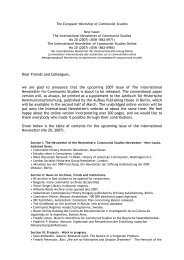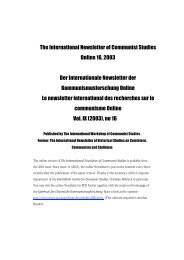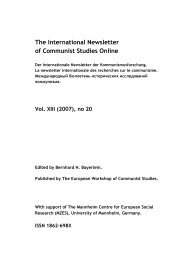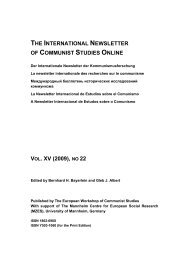VOL. XVI (2010), NO 23 - The International Newsletter of Communist ...
VOL. XVI (2010), NO 23 - The International Newsletter of Communist ...
VOL. XVI (2010), NO 23 - The International Newsletter of Communist ...
Sie wollen auch ein ePaper? Erhöhen Sie die Reichweite Ihrer Titel.
YUMPU macht aus Druck-PDFs automatisch weboptimierte ePaper, die Google liebt.
<strong>The</strong> <strong>International</strong> <strong>Newsletter</strong> <strong>of</strong> <strong>Communist</strong> Studies Online <strong>XVI</strong> (<strong>2010</strong>), no. <strong>23</strong> 20<br />
because it is only through practices that a discourse can materialise. 19 Not only does such<br />
an approach allow to observe a discourse in action, it also allows observing the creation <strong>of</strong><br />
knowledge from a bottom-up perspective, 20 and reconciles the antagonism <strong>of</strong> cultural<br />
patterns and individual action. 21 And in the specific Soviet case, it might help to reconcile the<br />
false polarity <strong>of</strong> “power” vs. “the people”, because the question the author poses is not how<br />
“the Bolsheviks” – polemically spoken – “manipulated” large parts <strong>of</strong> the population and<br />
“lured” them into believing communist dogmas, 22 but rather what practices could develop on<br />
the basis <strong>of</strong> this particular dogma and how the dogma gets re-created, reshaped and<br />
enhanced within and through “practical knowledge” (Pierre Bourdieu).<br />
In early Soviet society, through all social strata there was a diverse repertoire <strong>of</strong> practices to<br />
perform internationalism. <strong>The</strong>y could be employed according to the degree <strong>of</strong> political<br />
involvement (pre-revolutionary militant, post-1917 party functionary, sympathiser, bystander)<br />
or the belonging to a social group (worker, peasant, employee), but could also be unrelated<br />
to any <strong>of</strong> these criteria. <strong>The</strong>y could happen within or without the party or the mass<br />
organisations, and their degree <strong>of</strong> “spontaneity” and “straged-ness” could vary. Some have<br />
their direct roots in the workers’ movement tradition, some were “born” in Soviet Russia.<br />
Such practices, designed to enact a participation in a world-wide class struggle, could be (yet<br />
not limited to):<br />
- Individual and collective writing, addressed either to “internationalist” institutions like the<br />
Comintern’s “World Congresses”, or to persons representing internationalism. <strong>23</strong> While<br />
considering these letters, in the sense <strong>of</strong> a “performatively enhanced understanding <strong>of</strong><br />
text”, 24 as performative acts <strong>of</strong> empathizing with the world revolution, one also has to<br />
approach them on a semantic level to analyse whether the authors simply reproduce the<br />
templates <strong>of</strong>fered to them by the press and agitation, and whether they fill these templates<br />
with specific meanings which were probably not intended by the agitation’s creators and<br />
multipliers. A good example is a greeting address from prison inmates in the Soviet province<br />
to the 1 st World Congress <strong>of</strong> the Comintern, which relates communism’s abstract promise <strong>of</strong><br />
liberation to the concrete hope for liberation from prison. 25<br />
- Attending and/or organizing mass meetings and demonstrations for the internationalist<br />
cause, holding speeches on such occasions, composing meetings’ “resolutions”;<br />
19 For the theoretical basis, see: Andreas Reckwitz: Towards a <strong>The</strong>ory <strong>of</strong> Social Practices. A Development in<br />
Culturalist <strong>The</strong>orizing. // European Journal <strong>of</strong> Social <strong>The</strong>ory 5 (2002), 2, p. 243-263; Sven Reichardt: Praxeologische<br />
Geschichtswissenschaft. Eine Diskussionsanregung. // Sozial.Geschichte 22 (2007), 3, pp. 43-65; Karl H. Hörning,<br />
Julia Reuter (eds.): Doing Culture. Neue Positionen zum Verhältnis von Kultur und sozialer Praxis, Bielefeld,<br />
transcript, 2004.<br />
20 Comp.: Reichardt, Praxeologische Geschichtswissenschaft, p. 54.<br />
21 See: Glennys Young: Fetishizing the Soviet Collapse. Historical Rupture and the Historiography <strong>of</strong> (Early) Soviet<br />
Socialism. // Russian Review 66 (2007), 1, p. 95-122, here: p. 121-122. For the problem <strong>of</strong> structure and action, see<br />
e.g.: Thomas Welskopp: Der Mensch und die Verhältnisse. "Handeln" und "Struktur" bei Max Weber und Anthony<br />
Giddens. // Thomas Mergel, Thomas Welskopp (eds.): Geschichte zwischen Kultur und Gesellschaft. Beiträge zur<br />
<strong>The</strong>oriedebatte, München, Beck, 1997, pp. 39-70.<br />
22 This is – thus very simplified – the main point <strong>of</strong> Sergei Iarov’s study on forms <strong>of</strong> <strong>Communist</strong> persuasive practices<br />
in Petrograd (Konformizm v Sovetskoi Rossii. Petrograd 1917-1920-kh godov, Sankt-Peterburg, Evropeiskii Dom,<br />
2006), which unearths fascinating material and brilliantly puts it into context, but remains caught within this bipolarity.<br />
<strong>23</strong> For Soviet collective writing, see: Heike Winkel: Schreibversuche. Kollektive Vorlagen und individuelle Strategien<br />
in den "Briefen der Werktätigen". // Jurij Murašov, Georg Witte (eds.): Die Musen der Macht. Medien in der<br />
sowjetischen Kultur der 20er und 30er Jahre, München, Wilhelm Fink, 2003, pp. 59-79.<br />
24 Doris Bachmann-Medick: Cultural Turns. Neuorientierung in den Kulturwissenschaften, Reinbek bei Hamburg,<br />
Rowohlt, 2006, p. 106.<br />
25 Prison inmates from Vladimir to the VCIK, 12.3.1919. // RGASPI, f. 488 op. 1 d. 15 l. 13.














